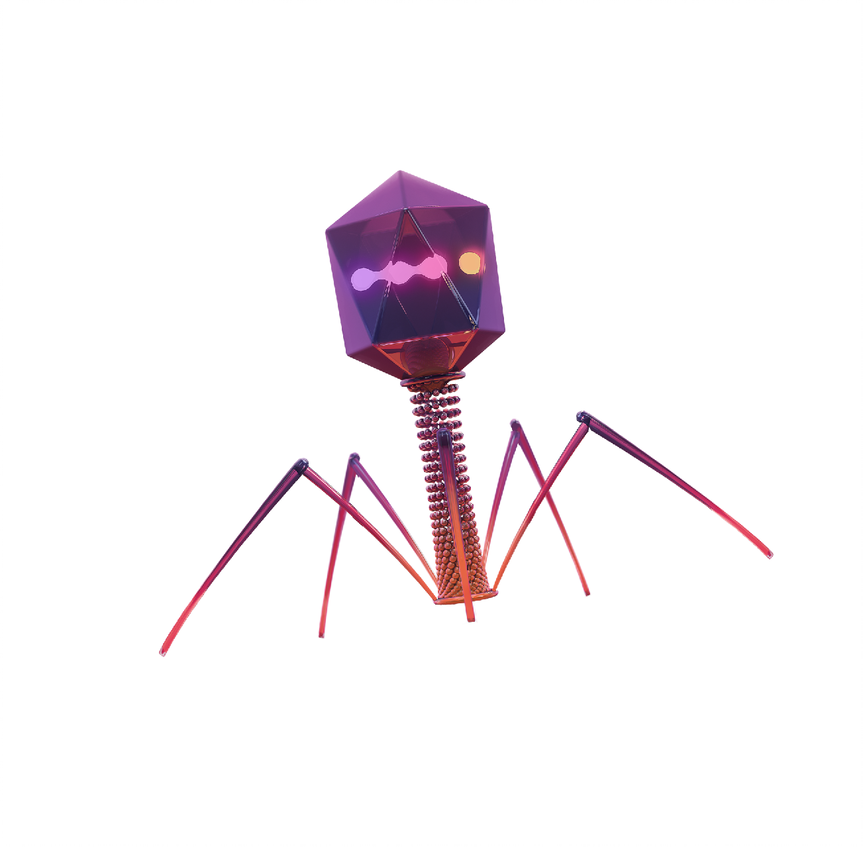



BAFACOL™ supports sustainable APEC prevention in poultry flocks
An in vivo study proves reduction in mortality and improvement of performance parametersColibacillosis, an infectious disease caused by the bacterium Escherichia coli, has become worrying issue in poultry flocks worldwide. Avian pathogenic Escherichia coli (APEC) infection is considered as one of the principal causes of morbidity and mortality, associated with heavy economic losses to the poultry industry. It causes airsacculitis, polyserositis, septicaemia and other mainly extraintestinal diseases in chickens, turkeys and other avian species. The first symptoms of the respiratory tract infection may be difficulty in breathing, nasal discharges, sneezing. After necropsy the observations usually are swollen kidney, reddish lungs, thin whitish layer over liver and heart. As the disease is often to laying hens, yolk sac infections are frequently observed towards the end of the egg incubating period, usually following faecal contamination of the egg surface. Diarrhoea, loose and wet droppings or undigested feed in litter may be another indicator of APEC infection.
Colibacillosis is enhanced by insufficient farm hygiene or unfavourable housing conditions, but it may be also spread by rodents or insects. Most of the diseases associated with APEC are secondary to environmental and host predisposing factors and bacteria are found in the intestinal microflora of even healthy birds, but it can be also preliminary acquired disease.
Multidrug resistance in Escherichia coli has become a fact, that is increasingly observed in veterinary medicine but also in human worldwide. E. coli is intrinsically susceptible to almost all clinically relevant antimicrobial agents, but this bacterial species has a great capacity to acquire antibiotic resistance. Very alarming is also the fact that use of a particular antibiotic can also cause the resistance to other antibiotics from the same class.
With more and more cases of antibiotic resistant colibacillosis, associated with high mortality and morbidity rates among poultry, treatment is not only costly but also not always effective. Moreover, the disease is hard to eradicate once outbreak is observed as it is often flock and hen house associated, with recurrent outbreaks within one round and in successive rounds in the same house.
Prevention is the best way to protect the flock from colibacillosis. There are several methods worth to consider. Applying favourable conditions for birds and reducing stress to minimum is always in corelation to general birds’ well-being and disease resistance. The pathogenic bacteria colonization can be prevented by controlling environmental contamination in order to avoid predisposing respiratory infections. Application of probiotics to competitively exclude pathogens from intestinal tract are one method. Other preventive methods include the reduction of the transmission of E. coli to newly hatched birds, by fumigating the eggs within 2 h after they have been laid and by discarding eggs that are cracked or those with obvious faecal contamination.
However, more and more popular becomes the application of bacteriophages as a powerful addition to conventional methods. The present article describes application of BAFACOL™ – bacteriophage-based feed additive that prevents colibacillosis. Bacteriophages are natural particles and are recognized as the most abundant biological agent on earth. They are very specific toward certain bacteria and do not interfere with beneficial microflora of the organism. BAFACOL™ is a bacteriophage cocktail that is specific to avian pathogenic Escherichia coli. It has been proved to have high efficacy with no side effects observed. It is safe to use with other antibacterial, feed additives and vaccines. In the described study we were measuring mortality rates in APEC challenged broiler chickens during normal production cycle. The effect of BAFACOL™ on productive performance was also monitored for the whole study.
Materials and Methods
Experimental approach
A male flock of healthy 1- day old 600 Vencobb 430Y broilers were randomly allocated to 50 pens, at 12 birds per pen. Birds were bedded on fresh wood shavings in clean pens in a previously disinfected house. Commercial diets (starter and grower) were used. Diets were provided to the broilers from feeders and water was provided from bell drinkers. Feed was divided of antibiotics and growth promoters. Environmental conditions during the trial (temperature, light and ventilation rate) were controlled and were appropriate for the age of the broilers. The birds were vaccinated against Infectious Bronchitis, Newcastle Disease and Infectious Bursal disease as per the prevailing commercial practices. The experiment lasted for 36 days.
There were five groups of birds. First group was negative control, the birds were healthy, and nothing was administrated to them. Second group was infected with APEC and not treated (positive control, T2). Third group was APEC infected and not treated, but BAFACOL™ feed additive was administered in recommended dose every other day for the whole life cycle (T3). Forth group was infected and received BAFACOL™ every day for the first two weeks (T4). Fifth group was infected, and antibiotic treated (T5). The experimental scheme is summarized in Table 1.
BAFACOL™ bacteriophage cocktail
BAFACOL™ produced by Proteon Pharmaceuticals SA (Poland) is a phage-based feed additive providing protection from APEC for all avian species. It is added to the drinking water, and 1L contains 100K doses (0,01ml per bird). In the described experiment two administration schemes were tested: the recommended for broiler chickens, which is every second day for the whole life cycle, and everyday administration for the first two weeks only.
Bacterial challenge
The bacteria used for infection originated from environment and were confirmed by genetic methods to be APEC. On the 5th day of the trial E. coli suspension was given through the oral gavage to all birds from groups T2-T5, in the group T1 saline was administered as placebo.
Antibiotic treatment
Enrofloxacin was administrated to infected birds from group T5 for 4 days, starting 5 days after infection. The exact dose was depending on the weight of a particular chicken and was 10 mg/kg of body weight.
Table 1: Experimental groups description
Group ID |
Infection |
Antibiotic |
Feed additive |
T1 |
No |
No |
No |
T2 |
With APEC on day 5 |
No |
No |
T3 |
With APEC on day 5 |
No |
BAFACOL™ days 0-35, every other day |
T4 |
With APEC on day 5 |
No |
BAFACOL™ days 0-14, every day |
T5 |
With APEC on day 5 |
Enrofloxacin days 9-13 |
No |
Measured parameters
Mortality and morbidity were observed on a daily basis. Mortality rate was calculated at the end of trial. Performance parameters: body weight, feed intake, water intake, FCR (Feed Conversion Ratio), EPEF (European Production Efficiency Factor); were measured at 0, 14, 21, and 35 days of trial and calculated at the end of experiment taking into account mortality corrections.
To study immunological response of the birds to BAFACOL™ relative expression ratios of immunomodulatory genes were measured in groups T1, T2 and T3. E. coli LPS level in blood serum was measured in all groups. The statistical analysis was performed.
Results
Mortality was monitored through the whole cycle and the mortality rate was evaluated at the end of the trial (Figure 1). In positive control group (T2), E. coli-infected birds’ mortality was 20%, which was significantly higher than in other groups (T1 (P<0.05), T3, T4 (P<0.001)). The lowest mortality rate (4.2%) was observed for group T3, receiving BAFACOL™ every other day for the whole period of trial, and for group T4 receiving BAFACOL™ every day for the first two weeks. The infected and enrofloxacin treated group - T5 mortality rate was 10%. The negative control group (T1) mortality was 8.3%.
 abDifferent superscripts in the same row denote statistically significant differences (P≤0.05). |
Figure 1. Mortality |
Performance parameters were assessed at 0, 14, 21, and 35 days of trial. The performance parameters obtained by APEC infected birds receiving BAFACOL™ were better or comparable with those obtained by non-infected birds from the negative control group. This suggests that BAFACOL™ has a general positive effect on birds’ welfare.
Mean body weight at the end of the trial (Figure 2) was significantly lower in group T2 than in T3 (P<0.05) receiving BAFACOL™ every day for the whole period of study. Mean daily weight gain within the overall period (Figure 3) was statistically significantly lower for group T2 than for all BAFACOL™ groups: T3 (P<0.001), T4 (P<0.05). In case of final weight at the 36th day of trial, the highest observed result was 2.54kg on average (T3), followed by 2.46 kg (T4). Worst performing group results were 2.41kg (T2). Mean daily feed intake (Figure 5) was the highest in group T3 (101g) and statistically higher than in group T2, that was 95g (P<0.05). There are no statistically significant differences between groups in average daily water intake (Figure 4).
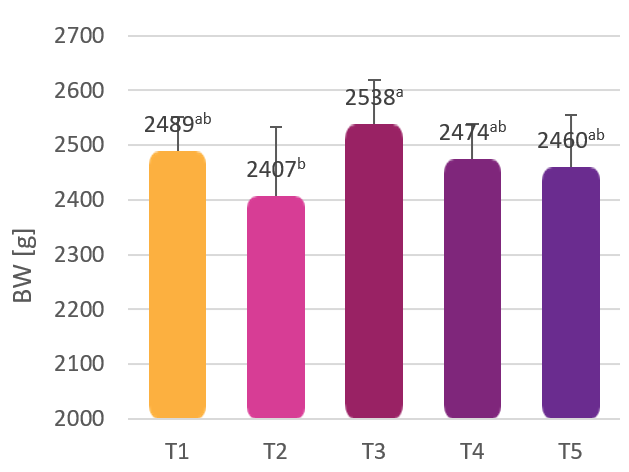 abDifferent superscripts in the same row denote statistically significant differences (P≤0.05). |
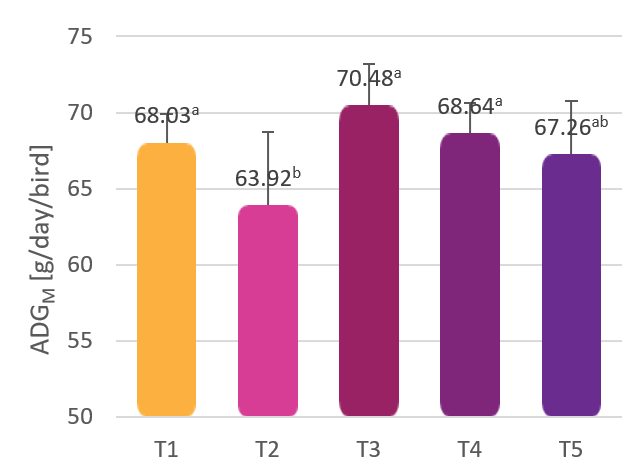 abDifferent superscripts in the same row denote statistically significant differences (P≤0.05). |
Figure 2. Mean body weight |
Figure 3. Average daily weight gain |
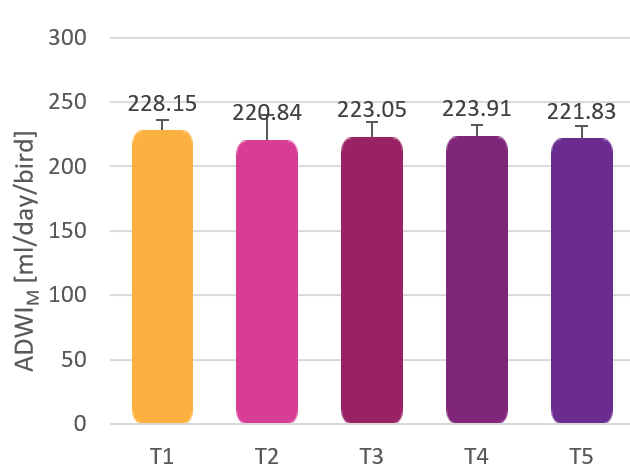 |
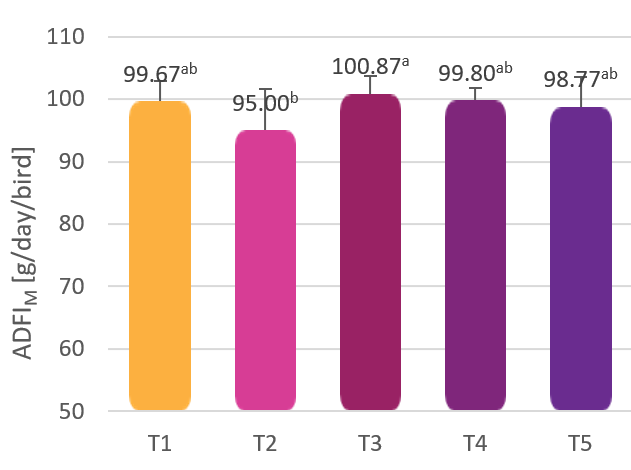 abDifferent superscripts in the same row denote statistically significant differences (P≤0.05). |
Figure 4. Average daily water intake |
Figure 5. Average daily feed intake |
Feed conversion ratio (FCR) was significantly lower in group T3 than in groups T1 (P<0.05), T2 (P<0.001), T5 (P<0.01). The resulted value for T3 receiving BAFACOL™ for the whole cycle is 1.43, the highest value was observed in positive control group T2 – 1.48. The FCR in T4 group receiving BAFACOL™ every day until 14th day of trial is 1.45. The negative control group and antibiotic treated group results are qual and are 1.47. Results are presented in Figure 6.
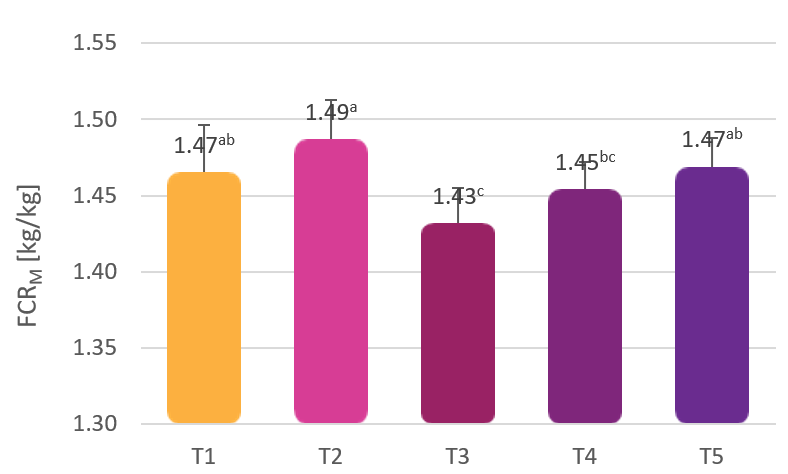 abDifferent superscripts in the same row denote statistically significant differences (P≤0.05). |
Figure 6. FCR |
European Production Efficiency Factor (EPEF) was significantly lower in group T2 than in groups T3 (P<0.001), T4 (P<0.05). The highest result was obtained in group T3 (BAFACOL™, every other day for the whole cycle) and equals to 493. For other BAFACOL™ group (T4) the result was 472, following by negative control group with result 465. Result for antibiotic treated group is 458 and for positive control group is 432. EPEF for all groups are showed in Figure 7.
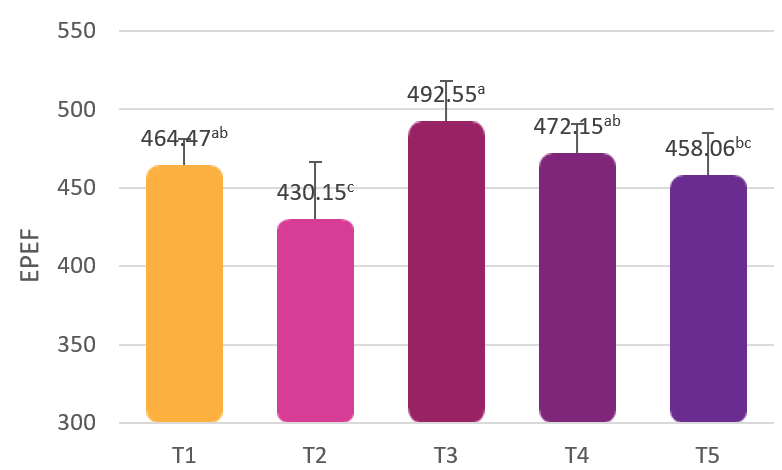 abcdDifferent superscripts in the same row denote statistically significant differences (P≤0.05). |
Figure 7. EPEF |
E. coli LPS level in blood serum (Figure 8) was the highest for positive control group (8,78 EU/L). The level was significantly lower in group T1, T4, (P<0.001) and T3 (P<0.05) than T2. For BAFACOL™ groups, T3, T4 LPS level was comparable to T1 negative control (6.63 EU/L): 6,94 EU/l, and 6.31 EU/L, respectively. LPS level was also significantly lower in group T4 (P<0.01) than in antibiotic treated group (T5) in which the level was only slightly lower (7.98 EU/L) compared to T2.
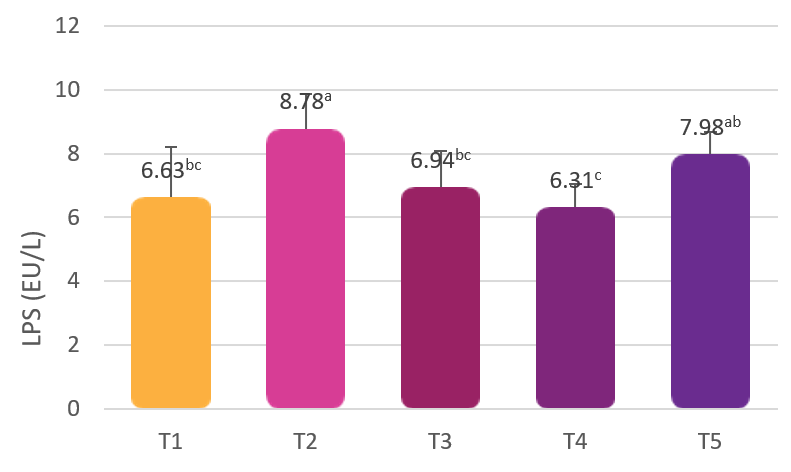 abDifferent superscripts in the same row denote statistically significant differences (P≤0.05). |
Figure 8. E.coli LPS level in blood serum |
Relative expression ratios of immunomodulatory genes have been evaluated for two proinflammatory cytokines – interferon γ (IFN-γ) and interleukin 6 (IL-6), as well as one regulatory cytokine – transforming growth factor β4 (TGF-β4). The study included groups T1, T2 and T3 only. The level of cytokines is shown as 2-ΔΔCt (relative fold gene expression) where ΔCt is the difference between cycle threshold for gene of interest and the inner control gene, while ΔΔCt is the difference between ΔCt for T1, T2, T3 and mean ΔCt of negative control T1. IFN-γ level was the highest in T3 group (2.390). In positive control group the level was higher than T1 (1.279) and lower than T3 (2.141), although the differences were not significant. IL-6 level was slightly higher in T3 group (1.438) compared to T1 negative control (1.113). In positive control IL-6 expression was lower than in T1 and T3 (0.614), but the differences were not significant. The regulatory TGF-β4 cytokine level was the highest in negative control group (1.054), in T3 the expression was half the level of T1 (0.514). In case of T2 positive control the level should be regarded as undetectable (0.005). The results are presented in Figure 9.

|
Figure 9. Expression ratios of immunomodulatory genes |
Discussion
Colibacillosis is causing huge concern in poultry industry. Birds mortality not only influence economical losses but also reduce the amount of available animal proteins for consumption. Conventional methods like antibiotic treatment of disease outbreak are costly, and due to emerging problem of antibiotic resistance, not always efficient. This may also cause risk to humans through the consumption of contaminated meat. The presented study shows that bacteriophages are a great tool for modern farms, that want not only prevent the APEC infection among their flocks but also care about sustainability. The tested feed additive BAFACOL™ administered to birds infected with APEC strains every other day for the whole cycle (group T3) and every day up to the 14th day of rearing (group T4) caused a significant reduction in mortality compared to the positive control group (T2), which indicates that it is effective in the prevention of colibacillosis. Moreover, birds receiving BAFACOL™ for the whole cycle (group T3) showed better results than birds from negative (T1) and significantly better results than positive (T2) control groups in terms of mean body weight, average daily weight gain, average daily feed intake and EPEF. In case of FRC, group T3 showed significantly better results than birds from negative (T1) and positive (T2) control groups. The mean body weight and FCR in group T4 receiving BAFACOL™ for first two weeks were like values obtained for non-infected control group (T1) and better than for infected control group T2. The average daily weight gain, average daily feed intake, mortality, EPEF in group T4 receiving BAFACOL™ for first two weeks were similar or better to values obtained for non-infected control group (T1) and significantly better than for infected control group T2.
Bacteriophage feed additive also ranks better when compared with antibiotic treatment. The study showed lower mortality in groups receiving BAFACOL™ than in group treated with enrofloxacin. Birds in groups T3 and T4 receiving BAFACOL™ achieved better main performance parameters (mean body weight, average daily weight gain, average daily feed intake, mortality, FCR and EPEF ( FCR and EPEF significantly better in T3 group)) than broilers treated with enrofloxacin (group T5).
Immunological parameters prove the efficiency of BAFACOL™ in limiting E. coli infection. High LPS level in serum of infected chickens may indicate systemic infection development. Significantly lower LPS level in BAFACOL™ groups T3, T4, (not significantly different from T1 negative control) suggests no systemic infection in those groups. LPS level in enrofloxacin treated group comparable to positive control shows significantly lower efficiency of the antibiotic against E. coli. For proinflammatory cytokines – IFN-γ and IL-6 – the highest expression was observed in group T3 (BAFACOL™, E. coli) which, together with the mortality and performance results, indicates more efficient immune response towards the pathogen. The regulatory TGF-β4 cytokine expression in T3 group was lower than the level in T1 group but higher than T2 positive control. The role of this cytokine is complex and low level of expression may suggest the difficulties in controlling exaggerated immune response as well as the lack of suppression of other cytokines.
BAFACOLTM is an innovative bacteriophage-based feed additive that was proved by this study to prevent Avian Pathogenic E. coli in poultry. BAFACOL™ enables to reduce the use of standard antibiotics, thus contributing to overall reduction in antibiotic resistance to antibiotics used in poultry meat production. By using BAFACOL™ feed additive farmers may contribute to removing antibiotics from the food chain, thus making animal protein production more sustainable and healthy. At the same time the flock is protected from the disease and the production is more efficient. Bacteriophages support the natural immune system of livestock through ensuring a healthy and well-balanced microbiome. Taking good care of the livestock, prevention of diseases, application of natural, efficient solutions, organic farming are more and more important to consumers nowadays. Bacteriophages, and BAFACOL™ product in particular, are great tool supporting this trend.
| References | ||||
|---|---|---|---|---|
| Lutful Kabir, S M. | ||||
| (2010) | Avian colibacillosis and salmonellosis: a closer look at epidemiology, pathogenesis, diagnosis, control and public health concerns.”. International journal of environmental research and public health | vol. 7,1 89-114. | doi:10.3390/ijerph7010089 | |
| Poirel L, Madec JY, Lupo A, Schink AK, Kieffer N, Nordmann P, Schwarz S. | ||||
| (2018) | Antimicrobial Resistance in Escherichia coli.. Microbiol Spectr | Jul;6(4). | doi: 10.1128/microbiolspec.ARBA-0026-2017. PMID: 30003866. | |
| Vandekerchove D, De Herdt P, Laevens H, Pasmans F. | ||||
| (2004) | Risk factors associated with colibacillosis outbreaks in caged layer flocks.. Avian Pathol. | Jun;33(3):337-42. | doi: 10.1080/0307945042000220679. PMID: 15223564. | |
| Vandekerchove D, De Herdt P, Laevens H, Pasmans F. | ||||
| (2004) | Colibacillosis in caged layer hens: characteristics of the disease and the aetiological agent.. Avian Pathol. | Apr;33(2):117-25. | doi: 10.1080/03079450310001642149. PMID: 15276977. |








